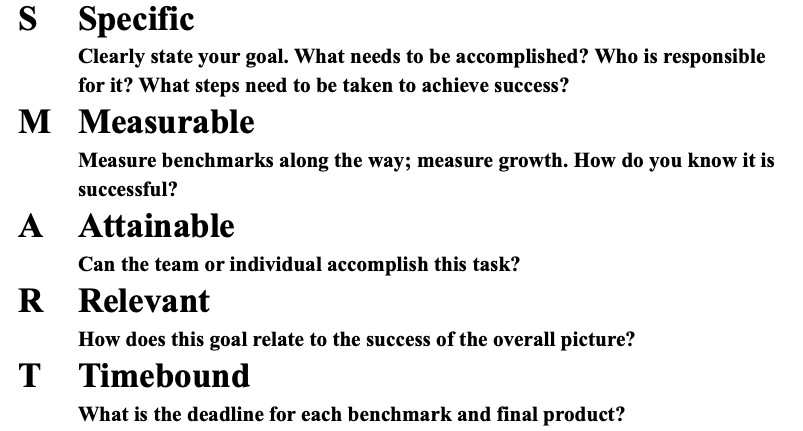Tips to Motivate Your Team
The following tips come from previous TAs, staff, reports, and other sources.
Tips
-
Share your vision.
-
Set clear and measurable goals using the SMART goals template. (diagram with the meaning is viewable at the bottom of the page)
-
Clearly explain the relevance of your vision and your goals to the team.
-
-
Communicate with your team frequently.
-
Be transparent about processes. How was a decision made? If you do not know something, please ask.
-
Stay up-to-date on what needs to be done.
-
Give team members a voice. Listening to their ideas, opinions, and feedback.
-
Check-in regularly with your team. This can include work, well-being, and more.
-
Be available for conversations, questions, and providing help.
-
Say “no” tactfully by including a reason.
-
-
Encourage your team.
-
Get to know your team. What motivates them to work? What are their strengths and weaknesses? What drives them to create great work? Connect with your team.
-
Encourage teamwork, this makes employees feel less isolated and more engaged. You can do this by holding team-building activities throughout the semester.
-
Step up when there is a lack of motivation and/or communication.
-
-
Give healthy feedback.
-
Celebrate successes in labs and meetings.
-
Explain why the task was good and how it helped to benefit the team.
-
Don’t punish failure.
-
-
Provide opportunities for development.
-
Give team members roles and responsibility. This will add variety to their day.
-
Encourage creativity; Don’t let your people become bored.
-
Break out of comfort zones by changing up location and implementing friendly challenges.
-
Don’t micromanage the work team members are completing.
-
Give the team a break if they seem collectively stressed.
-
-
It is what you make of it. Be a role model, be active and learn with the students.
-
What to do if you’re still struggling: Reach out to fellow teaching assistants and The Data Mine staff for ideas, help, and support.
What tips would you add?
